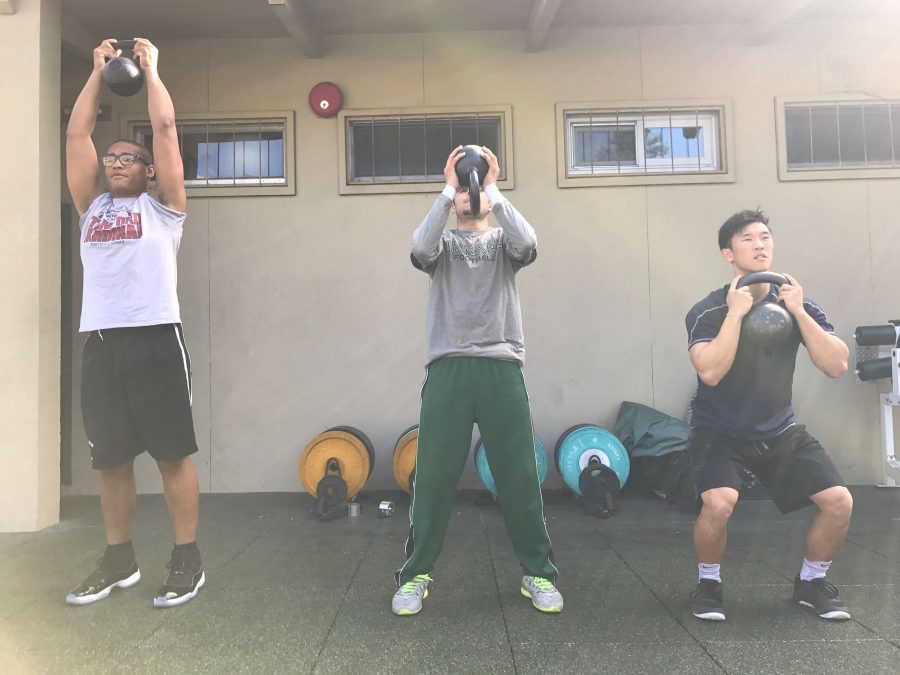Peak performance: benefits of conditioning
Jadan McDermott (11), Norman Garcia (12), and Will Park (12) work out at the weight room. Conditioning is a vital part of an athlete’s training.
March 28, 2017
For water polo, it’s Tabatas. Tennis? Liners. Basketball? Suicides. Wrestling? The Hallway.
The last half hour of practice that athletes dread the most approaches quickly: conditioning time. It seems so pointless—the sprints and the miles all leave you exhausted.
“Can’t we just work on technique?” your body begs as you follow your coach’s orders and doggedly run laps. Each breath comes out harder than the previous as you think to yourself, “I never have to run this much in actual games. What’s the point of all this running?”
Although athletes know that conditioning exercises are very important, they may not know why. According to the National Strength and Conditioning Association (NSCA), the purpose of conditioning is not to mimic game conditions, but rather to work out the muscles so that they do not tear under strain and to reduce the chance of sports injuries. As an athlete’s body is analogous to a machine, conditioning can be compared to maintaining a machine.
As athletes, we can familiarize our bodies with the athletic motions we have to perform during games and loosen our muscles at the same time, significantly decreasing the chances of injury.
The more we practice while we are tired, the better our bodies can perform in a game under those conditions. By practicing while beset by fatigue, we will be more familiar with our bodies’ limits and be ready to perform under those conditions.
We usually find that our performance deteriorates as the game clock ticks down, so being well-conditioned will give us an edge to win by outlasting and outperforming our opponents. I certainly find this to be true, as seeing my opponent more tired gives me the motivation necessary to strike when he is weak. By being in better shape than our opponents, we can demoralize the opposing team. After all, how can they not be disheartened watching us hop, skip and jump when they’re barely able to move themselves.
“Personally I don’t like it, but I believe it is necessary to get better; For football, it is the strongest guy that wins, because a 200 pound guy can destroy a 170 pounder easily, so it’s all about getting bigger, faster, and stronger,” said senior football player Saketh Gurram. “It’s like studying for a test. You want to get a good grade, but you won’t get the good grade unless you study for it. Conditioning is like the studying part of testing.”
Lastly, doing conditioning exercises can help you keep fat off your body as well as help keep your body looking good, as many conditioning exercises are geared toward repetition and burn calories and fat quickly. According to Calorielab.com, exercises like circuit training and heavy calisthenics can burn almost 500 calories an hour.
Conditioning exercises are undoubtedly boring and extremely tiring, but the benefits to you as an athlete and to your body is immense. So, next time your coach starts the conditioning drills, turn that frown upside down.
This piece was originally published in the pages of The Winged Post on March 28, 2017.


















![“[Building nerf blasters] became this outlet of creativity for me that hasn't been matched by anything else. The process [of] making a build complete to your desire is such a painstakingly difficult process, but I've had to learn from [the skills needed from] soldering to proper painting. There's so many different options for everything, if you think about it, it exists. The best part is [that] if it doesn't exist, you can build it yourself," Ishaan Parate said.](https://harkeraquila.com/wp-content/uploads/2022/08/DSC_8149-900x604.jpg)




![“When I came into high school, I was ready to be a follower. But DECA was a game changer for me. It helped me overcome my fear of public speaking, and it's played such a major role in who I've become today. To be able to successfully lead a chapter of 150 students, an officer team and be one of the upperclassmen I once really admired is something I'm [really] proud of,” Anvitha Tummala ('21) said.](https://harkeraquila.com/wp-content/uploads/2021/07/Screen-Shot-2021-07-25-at-9.50.05-AM-900x594.png)







![“I think getting up in the morning and having a sense of purpose [is exciting]. I think without a certain amount of drive, life is kind of obsolete and mundane, and I think having that every single day is what makes each day unique and kind of makes life exciting,” Neymika Jain (12) said.](https://harkeraquila.com/wp-content/uploads/2017/06/Screen-Shot-2017-06-03-at-4.54.16-PM.png)








![“My slogan is ‘slow feet, don’t eat, and I’m hungry.’ You need to run fast to get where you are–you aren't going to get those championships if you aren't fast,” Angel Cervantes (12) said. “I want to do well in school on my tests and in track and win championships for my team. I live by that, [and] I can do that anywhere: in the classroom or on the field.”](https://harkeraquila.com/wp-content/uploads/2018/06/DSC5146-900x601.jpg)
![“[Volleyball has] taught me how to fall correctly, and another thing it taught is that you don’t have to be the best at something to be good at it. If you just hit the ball in a smart way, then it still scores points and you’re good at it. You could be a background player and still make a much bigger impact on the team than you would think,” Anya Gert (’20) said.](https://harkeraquila.com/wp-content/uploads/2020/06/AnnaGert_JinTuan_HoHPhotoEdited-600x900.jpeg)

![“I'm not nearly there yet, but [my confidence has] definitely been getting better since I was pretty shy and timid coming into Harker my freshman year. I know that there's a lot of people that are really confident in what they do, and I really admire them. Everyone's so driven and that has really pushed me to kind of try to find my own place in high school and be more confident,” Alyssa Huang (’20) said.](https://harkeraquila.com/wp-content/uploads/2020/06/AlyssaHuang_EmilyChen_HoHPhoto-900x749.jpeg)







